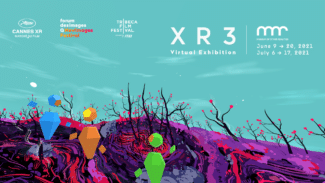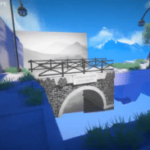This week, the Museum of Other Realities launched its XR3 exhibition — a joint project between Cannes XR, the NewImages Festival and the Tribeca Film Festival. Not only does the exhibition feature some fantastic immersive VR content, but it presents it in a way that feels fresh, appropriate and the right direction for VR film festivals.
With more and more immersive content appearing in film festival lineups over the last couple of years, there have a few attempts to create a cohesive immersive festival experience. However, it feels like the Museum of Other Realities (MOR) has properly cracked the code with its XR3 exhibition this year. It’s a joint exhibition staged by the virtual museum and three organizations — Cannes XR, NewImages and Tribeca — and it results in something that feels like a true vision and creative blueprint for the future of immersive festivals.

The focus of XR3 is allowing discovery of immersive festival content in a seamless and accessible way — a task in which it overwhelmingly succeeds. It’s the best structure and presentation of any immersive VR festival content I’ve seen to date.
Each immersive experience comes in its own separate app that runs independently from the MOR app on your PC. In the past, redeeming codes, downloading individual experiences and switching apps with no cohesive hub could make some immersive festivals feel a bit disjointed. MOR’s XR3 exhibit circumvents these problems by installing an entire festival selection as DLC, and then allowing you to discover them in a festival hub within the museum.
Everything is handled by MOR, including switching between experiences and apps, without the need for you to remove your headset. The idea of a festival world or hub has been done before, but XR3 feels like the best version to date and should be the standard going forward.

Each festival is given it’s own wing in the museum, pictured above, with portals on either wall that lead to introductory rooms for each experience. Each room is customized by the creators to thematically fit with their experience, and features a glowing blue shaft of light in the center, pictured below. When you touch the light, MOR will load up the experience’s app and move you into the standalone experience, without you having to do anything. Likewise, once it’s over, you’re sent back to the museum, right where you left off.

It’s a elegant solution, executed perfectly. More importantly, it brings the immersive festival experience closer to how we experience art in real life, while still also preserving the uniqueness of VR as a platform.
XR3 Festival Access, Pricing and Dates
In terms of pricing, festival passes are available to purchase for $15 each on Steam as DLC content for the Museums of Other Realities app. Without the DLC pack installed, you can still walk around the festival area, but any attempt to start the content will be met with a prompt to buy and/or download the DLC festival pass content first. If you’re downloading all 3 festival selections, it comes in at a hefty 60GB add-on to the regular museum app, so leave time for downloading.
Only the NewImages and Tribeca selections are available at the moment. They’ll be around until June 20, after which XR3 will shut down briefly. On July 6, it reopens with access to the Cannes XR portion of the exhibit until July 17. To make the festival more accessible and encourage participation, the base Museum of Other Realities app is available for free until July 20 (usually priced at $20). If you redeem it now, you’ll be able to keep the app and retain access to the museum after XR3 is over as well.
XR3 Tribecca and NewImages Impressions
We had a chance to check out some of XR3 a few days early. I haven’t been able to try everything due to time constraints, but what I did try was quite compelling. More than ever, experiences seem to be honing in on elements that are unique and elevated by the VR medium. Many also seem to be finding the right balance between interactive elements and passive viewing — an area I’ve previously found to be a precarious tightrope that some fail to walk.
Madrid Noir
A personal highlight was Madrid Noir, available as part of Tribeca, which was already on my radar before the festival. This latest immersive experience from Atlas V (the same group behind the Colin Farrell-narrated Gloomy Eyes) is a delight. It follows a young girl Lola, living in Madrid in the early 20th century, as she investigates the strange comings and goings of her uncle as he travels across the city at night.

Directed by James A. Castillo, Madrid Noir truly stuns from a composition and visual perspective. Some sections are staged and presented like theater — encouraging passive viewing — while others are framed and set up in a manner closer to a traditional video game, often requiring you to interact with the environment as the story plays out around you. The animation and artwork is superb and aesthetically delectable, while the story keeps things simple but nonetheless intriguing. Overall, it does feel a little on the long side at around 45 minutes, but there’s an intermission about two thirds of the way through, so you could break it up into two sessions if need be.
My experience was marred by quite a few consistent visual bugs — some objects would only render in one eye from certain angles, and moving my head often messed with a scene’s lighting effects. I can’t say whether the glitches were unique to my experience or whether they’re a common occurrence.
Despite this, it remained an enjoyable ride and is a fantastic experience overall.
Jailbirds

Jailbirds is another fascinating experience on offer, available as part of both the NewImages and Tribeca selection. Directed by Thomas Villepoux, it’s a short immersive film, roughly 5 minutes, with very little interactivity. Following two cellmates who are paid a visit by the prison’s warden, Jailbirds features a breathtaking and creepy aesthetic that looks almost like it was all drawn with a lead pencil. The experience is short, intimate and quite unsettling at times — highly recommended.
Marco and Polo Go Round

Another fantastic experience from the NewImages selection is Marco and Polo Go Round, directed by Benjamin Steiger Levine. It follows a frustrated couple through a 10-15 minute conversation navigating their complicated relationship. As time goes on, things start getting weird — the conversation continues but the gravity of objects in the room begins to invert. Things go flying up to the roof in what feels like a metaphor for the chaos of the still-continuing conversation.
This creative imagery and storytelling feels so appropriate to witness in VR, taking proper advantage of the different ways we can experience narrative in the medium. There’s no interactivity here either, but it’s not to the experience’s detriment — the dialogue is well-written and, along with the increasingly wacky environmental antics, it keeps your interest throughout. To cap it all off, it uses a beautiful, soft watercolor-like aesthetic that fits the melancholic mood perfectly.
If you’ve got time, give Marco and Polo Go Round a look.
Will you be checking out the XR3 exhibition at the Museum of Other Realities? Let us know what your favorite experiences are in the comments below.






